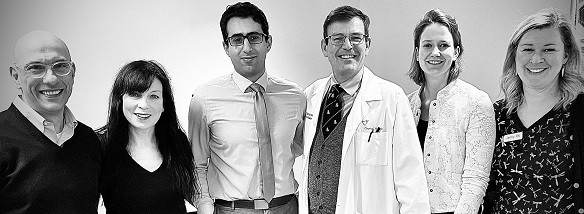Maritime Lateral Skull Base Program
Working together for the best lateral skull base care
Neurosurgeon
Dr. Simon Walling
Research coordinator
Andrea Hebb
Contact
Phone: 902 473-4370
Fax for new referrals: 902 425-9572
The Maritime Lateral Skull Base Clinic provides coordinated care through Otolaryngology, Neurosurgery and the Stereotactic Radiotherapy Group to patients with unilateral or bilateral vestibular schwannomas, acoustic neuromas and a range of other lateral skull base tumours.
The program provides coordinated care to over 650 patients with a range of lateral skull base tumours including vestibular schwannomas, other cerebellopontine angle tumours, lesions of the petrous apex and jugular foramen. Patients are carefully assessed and appropriate plans formulated. When treatment is required, the experts on our team provide a full range of treatment options including surgery, Stereotactic Radiation Therapy (SRT), balance and hearing rehabilitation. This program is unique in Canada in allowing members from all disciplines to formulate management decisions in the same clinic.
NF2 Clinics continue to be held once every 2nd month. This clinic is dedicated to patients with Neurofibromatosis Type 2 and includes collaboration with Medical Genetics, Radiology, Nova Scotia Hearing and Speech and Ophthalmology
This program, unique to the Maritime Provinces and much of Canada, provides comprehensive care to over 700 patients with Cerebellopontine angle (CPA) tumors in a multidisciplinary clinic. Patients are seen by both Neurosurgery and Otolaryngology. Collaboration with the Stereotactic Radiosurgery Group ensures coordinated assessment, treatment and follow-up.
Our program referrals have increased tremendously, with 47 new Maritime Lateral SBC referrals, to include New Brunswick and PEI, representing a substantial increase in the number of patients seen in 2014 from previous years.
Lateral skull base research
We have developed research along several fronts, including:
- What is useful hearing? Speech in noise comprehension with asymmetric hearing in acoustic neuroma subjects: when does the tumour ear stop contributing to binaural hearing
- A database of tumour growth and outcomes; one of the largest series in the world with the “wait and scan” policy
- Patient expectations and attitudes to acoustic neuroma – questionnaire for all patients in our database
- Subjective hearing handicaps measured with standardized instruments
- Tinnitus and quality-of-life questionnaires with each clinic visit

 Dr. Simon Walling, (Neurosurgery)
Dr. Simon Walling, (Neurosurgery)